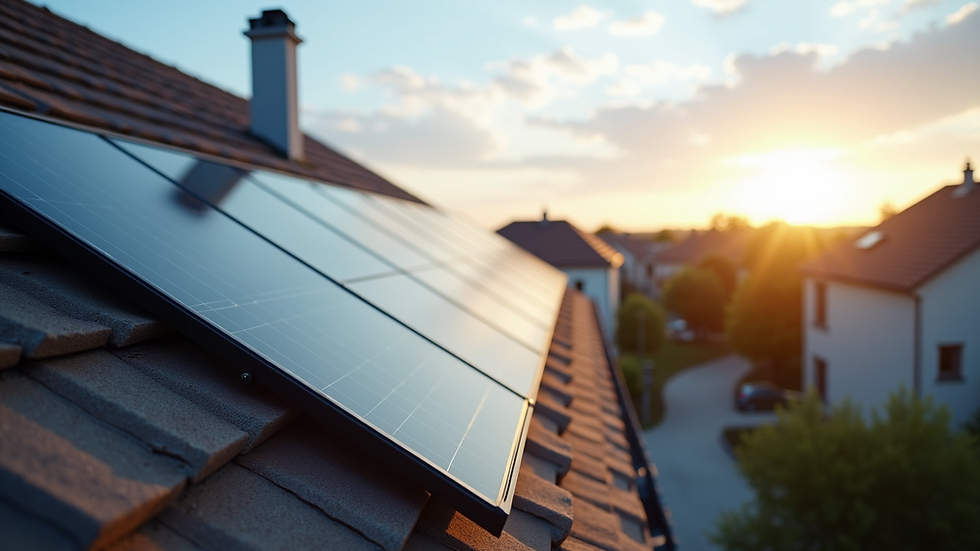Unlocking the Solar Payback Period: How Quickly Will Your Solar System Start Saving You Money?
- Bill Adams
- Aug 8
- 4 min read
Investing in solar energy is more than just a commitment to protecting the environment. It's a serious financial decision that can lead to substantial savings over time. More homeowners and businesses are turning to solar power, driven by the desire to lower energy costs while promoting sustainability. A vital question emerges: How quickly will your solar system start saving you money? Understanding the solar payback period is key to answering this question.
What is the Solar Payback Period?
The solar payback period is the time it takes for your solar system to generate enough savings to cover its installation cost. This means it's the duration needed for you or your business to recover the initial investment through reduced electricity bills.
Typically measured in years, the payback period provides insight into the financial viability of solar energy. Many factors influence this timeframe, including local energy prices, system efficiency, available incentives, and local sunlight exposure.
Factors Influencing the Payback Period
1. Initial Installation Costs
The upfront cost of a solar installation can differ greatly based on system size, panel quality, and installation difficulties. Homeowners can generally expect costs to range from $15,000 to $25,000. For example, a 5 kW solar system might cost about $16,000, while a top-of-the-line 10 kW setup could exceed $30,000. Higher quality components may lead to lower maintenance over the life of the system but can extend the payback period due to higher initial costs.
2. Energy Prices and Savings
The price of electricity in your area significantly impacts your savings. In regions with higher energy costs, the return on your investment tends to be quicker. For instance, if you pay an average of $0.20 per kWh and typically use 1,000 kWh a month, that’s $200 monthly. If going solar reduces that bill by 80%, you would save $160 each month. Conversely, in areas where electricity costs only $0.10 per kWh, saving just $80 a month could mean a longer wait for your payback.
3. Solar Incentives and Tax Credits
Different incentives and tax credits can reduce the upfront cost of a solar installation, thus shortening the payback period. As of 2023, the federal solar tax credit enables you to deduct 30% of the solar installation costs from your federal taxes. If your system costs $20,000, this means a tax credit of $6,000, bringing your effective cost to $14,000. Additionally, many states offer rebates or performance-based incentives that can enhance your savings.
4. Solar System Efficiency
The efficiency of solar panels directly affects energy production. More efficient panels convert sunlight into electricity better and can lead to greater savings. For instance, while standard panels might operate at 15% efficiency, high-efficiency panels can reach up to 22%. This difference could mean generating significant additional energy. The upfront cost may be higher, but the lower payback period can make it worth considering.
5. Sunlight Exposure
The amount of sunlight your panels receive is essential. Homes in sunny areas like Arizona or California can generate much more electricity compared to those in less sunny regions. For example, a solar system in a sunny locale may produce around 1,500 kWh per installed kW per year, while the same system in a cloudier region might only yield 1,200 kWh. Tools like solar maps or consultations with local installers can help assess your location's solar potential.
Calculating Your Solar Payback Period
Calculating your solar payback period is straightforward. Follow these steps:
Determine your total solar system cost: This includes all costs associated with purchasing and installing your solar panels and equipment.
Calculate your monthly energy savings: Analyze your past electricity bills to estimate how much your costs will decrease with solar.
Divide your total system cost by your monthly savings: This will yield the number of months it takes to recover your investment. To get an annual estimate, simply divide by 12.
For example, if your system costs $20,000 and your monthly saving post-installation is $200, your payback period would be 100 months, or just over 8 years.
Example Case Study
Let’s consider a scenario:
System Cost: $18,000
Monthly Electric Bill Before Solar: $250
Projected Monthly Savings Post-Solar: $200
Tax Credit Received: $4,500
With the tax credit applied, the total cost of the system becomes $13,500. By dividing this amount by the monthly savings of $200, you'll find a payback period of 67.5 months, or about 5.6 years.
This example highlights how crucial incentives, system costs, and energy bills are in determining the payback period.
The Long-Term Benefits of Going Solar
While the payback period is a key consideration, reflecting on the long-term benefits of solar energy is just as important. Once your initial investment is recouped, savings on your utility bill can be significant, often exceeding tens of thousands of dollars over the lifetime of the system, which can last 25 years or more.
Additionally, installing solar can increase your property value. Homes with solar systems often sell for around 4% more than similar homes without them. Beyond financial gains, switching to solar reduces your carbon footprint, helping create a more sustainable future for everyone.

Making the Most of Your Solar Investment
Understanding the solar payback period can guide your decision on investing in solar energy. By evaluating the factors like installation costs, energy prices, available incentives, efficiency, and sunlight exposure, you can gain a clearer picture of how quickly your investment will pay off.
While the initial costs may seem overwhelming, the long-term savings can be substantial. If you're considering going solar, now is an ideal time to discover its benefits for both your finances and the environment. By understanding your solar payback period, you can harness the sun's energy for a sustainable future.




Comments